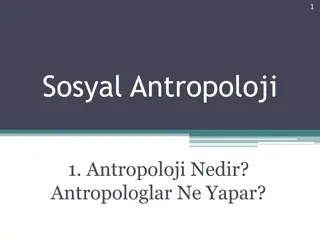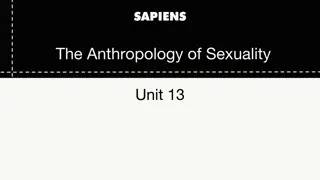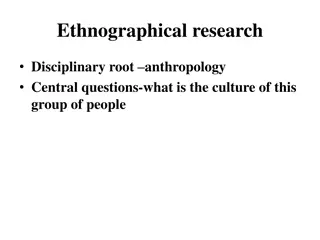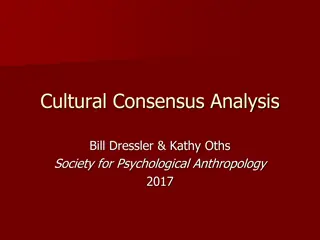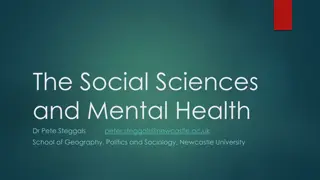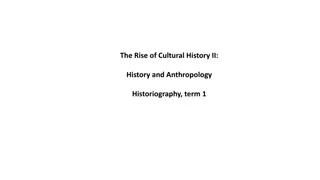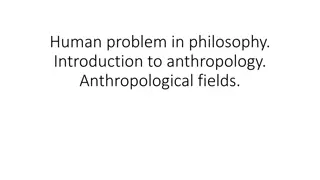Understanding the Intersection of Social Anthropology and Health
Social anthropology investigates the cultural and social dimensions of health, providing insights into how illness and medical care are shaped by cultural contexts. This discipline explores the impact of culture on individual health, highlighting how collective beliefs influence perceptions of health and illness. By examining the contributions of anthropology to our understanding of health, we recognize the critical role of culture as a determinant of well-being.
Download Presentation

Please find below an Image/Link to download the presentation.
The content on the website is provided AS IS for your information and personal use only. It may not be sold, licensed, or shared on other websites without obtaining consent from the author. Download presentation by click this link. If you encounter any issues during the download, it is possible that the publisher has removed the file from their server.
E N D
Presentation Transcript
Session aims To explore what social anthropology as a discipline is To identify how social anthropology contributes to understandings of health and illness To identify how culture as a social context relates to and affects health
What is social anthropology? Social anthropology is the study of all aspects of society from a cross-cultural perspective Historical anthropology was concerned with other exotic cultures Contemporary anthropology is concerned with all cultures The anthropology of health and illness explores the social and cultural dimensions of health, ill health and medicine
The contribution of anthropology to understandings of health Ethnographic studies have demonstrated that illness and medical care are socially constructed according to the cultural context in which we live Ethnographic studies have shown how therapeutic interventions can be influenced by cultural practices (Prout 1996) Ethnographic studies have explored the attitudes of professions in relation to health care and health promotion (Kingfisher & Millard 1998) In summary, medical anthropology explores health and illness within its cultural context because culture is important in relation to health
Culture and health Individual health is affected by social context including cultural influences Culture is the collective beliefs, assumptions and values that are communicated between people within a society (Boyden 2004) Put simply, culture is how we make sense of and understand the social world in which we live Helman (2000:2) defines culture as an inherited lens , through which the individual perceives and understands the world We all live in a specific cultural context which functions as either a positive or negative determinant of health
Culture and health Culture determines health and illness in many ways Furedi (2008) argues that people s perceptions of health and illness are largely shaped by the culture in which they are located ...culture does considerably more than shape illness as an experience; it shapes the very way we conceive of illness. (Kleinman 1977:4) Napier et al (2014:1609) describe culture as a set of practices and behaviours defined by customs, habits, language, and geography that groups of individuals share.
Different cultural health practices Van Telijingen (2000) illustrates that childbirth in the Netherlands is viewed as a natural and healthy condition, where medical intervention is not necessary and therefore is limited. Einion (2018) points out that medicalization disempowers women in their choices during pregnancy and childbirth across many contexts, as they consent to practices that they believe are for their best interests, where they may simply need respectful humanistic care.
Cultural norms affect health People make sense of their symptoms in different ways and act according to their cultural beliefs Zborowski (1950s) argued that pain was viewed differently amongst ethnic groups when he conducted a study in a New York Cregan-Reid (2018a) discusses how the modern- age culture of comfortableness, which includes spending more time indoors, has led to increased vitamin D deficiency and increased allergies amongst children as they need more access to daylight
Illness behaviour is socially divided Illness behaviour is also influenced by divisions within societies as well as between them Middle-class people are more likely to exhibit illness and health-seeking behaviour when compared to working-class people experiencing the same symptoms (Koos 1954) Manstead (2018) notes that socioeconomic status impacts upon thoughts, feelings and behaviour, which leads to different health behaviours and outcomes through complex causal mechanisms
Experiencing illness lay perspectives Studying illness accounts has led to useful insights into the meanings attached to specific illnesses. Klienmann (1988) distinguishes: Illness problems practical difficulties caused by the illness, related to socio-cultural expectations. These often include shame associated with disfigurement and loss of normal functioning and frustration associated with not being able to perform usual roles such as work. Illness complaints these are the descriptions that the patient brings to the practitioner (these do not necessarily include descriptions of the illness problems). These social experiences of illness and treatment are bound up with cultural interpretations and meanings. People understand illness and disease in a variety of dynamic ways.
What do lay beliefs mean? They help people to make sense of their illness experiences They influence illness behaviour, e.g. what foods we eat and the attitudes we believe we should exhibit in order to recover They influence ideas about illness causation They influence attitudes to treatment
Example lay beliefs: screening Cancer screening programmes operate in a range of countries. For example, in the UK routine cervical cancer screening is available for women over the age of 25 and bowel cancer screening is offered to everyone over the age of 55 years. However, people do not always opt to access these screening opportunities. Roberts et al (2018) explored knowledge about screening in the USA and found that low levels of understanding in some population groups (men and underserved communities) were linked to low- uptake of screening offers. They concluded that people make decisions about screening based on incorrect beliefs. Tsuchiya (2015) also explored lay beliefs about cancer in Japan and found that fear of the illness as a threat to the future was a common lay belief that influenced the uptake of screening.
Culture and treatment Medical anthropology has investigated the use of both medical and alternative treatments and why these are used in a number of different contexts. Illness in some cultures is believed to be caused by external forces, evil spirits and possessions resulting in treatment as ritual based, including ceremonies to drive away spirits, witchcraft, voodoo and the use of Shamans and traditional healers (Kirmayer 2004). Western medicine works within the biomedical model, and is individualistic in its treatment approach. This tends to led to a curative approach based upon the diagnosis of diseases. Seeking treatment from professionals is however not the first step in many cultures, as individuals often self-medicate prior to this. The growth of social media influencers in recent years had led to the increased promotion of alternative approaches by lifestyle gurus, who in some instances are making false claims to sell products linked to broader cultural concerns about wellness (Baker and Rojek 2019).
Cultural representations of health and illness How illnesses are described and understood varies significantly across cultures Many languages do not contain a word to describe cancer (Dein 2006) yet this does not indicate that it does not exist Helman (2007) argues that some diseases, especially those that are difficult to treat, explain and control, become symbols for more general anxieties that people have
Illness metaphors Some conditions become more than just diseases, they become metaphors (Sontag 1989) and as a result become stigmatized Cancer is still often used as a noun in the media to describe an array of problems such as drug abuse, immigration and crime AIDs is often negatively described metaphorically too, associated with pollution and ultimately stigmatized Walker (2019) notes that individuals with HIV report ongoing experiences of shame, fear and stigma, maintaining the disease as having the most social of statuses, in the cultural context of the globalized North
Culture and mental illness Medical anthropologists demonstrated that there are no universal categories of mental illness across all cultures. Geeraert (2018) points out that what is seen as normal in one culture (modesty) may be described as a mental health problem in another (social phobia). In Aboriginal cultures, notions of longing for, crying for and being sick for their country have exactly the same symptom base as depression (Vicary & Westerman 2004). Research has also shown differences in understandings in relation to schizophrenia: in some cultures hallucinatory behaviour and suspiciousness are not necessarily seen as signs of mental illness (Pote & Orrell 2002).
Culture and mental illness Cultural context can influence the incidence of mental ill- health. Those who exist in a culture that promotes resilience- producing characteristics are much more likely to be able to cope with stress and therefore less likely to experience mental ill-health (Newbigging 2018). Different cultures encourage certain personality types such as hardiness, ego strength, optimism and humour. Mental health problems are heavily socially influenced: feelings such as despair and hopelessness are located in individual brains, but are also related to patterns of interaction with families, communities and indeed wider society (Marsella 2007).
Cultural influences upon health We are often not consciously aware of the culturally patterned nature of our health behaviour as this is taken for granted and feels normal. Cultural influences are negative when, for example, they are supportive of health damaging behaviours, such as drinking excessive amounts of alcohol. Alcohol intake is embedded in a matrix of cultural values and influenced by the expectations of different social groups. Sudhinaraset et al (2016) argue that alcohol use needs to be researched within the cultural contexts and environments where people live and interact. Berezin and Eads (2016) discuss growing resistance to vaccinations as part of a culture of individual risk, reflecting wider cultural changes in narratives about the safety of vaccinations.
Health-damaging culturally acceptable behaviours The culture of obesogenic environments: inactivity, changes in dietary habits and environmental factors combine to support increased rates of obesity Western culture is generally damaging to health: materialism and individualism are detrimental to health (Eckersley 2005) the 24-hour, round-the-clock culture disturbs sleep patterns and negatively affects health (Stanley 2009) Thorley (2019) notes that western culture has abandoned breastfeeding as a normal practice despite it being a biologically normal activity
Summary Medical anthropology is a sub-discipline of social anthropology that demonstrates the importance of culture as a determinant of individuals understandings and experiences of both and illness and treatment Medical anthropology when critically analysing health has strongly demonstrated that health is overwhelmingly social, with culture as a key determinant of health beliefs, behaviour and treatment Anthropology shows that health and illness are culturally located and that key social and cultural meanings are associated with health





